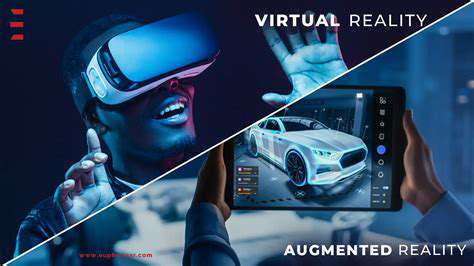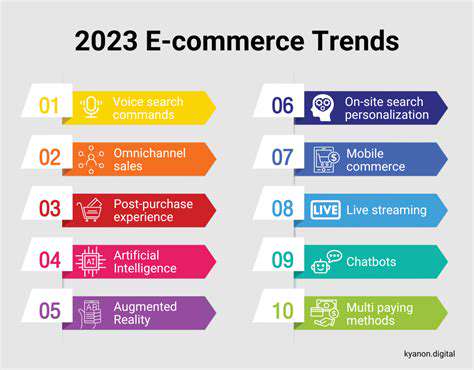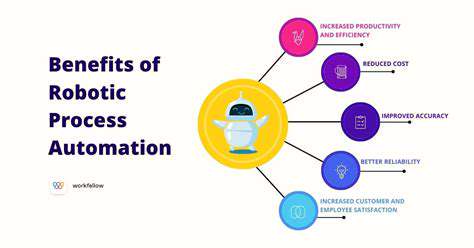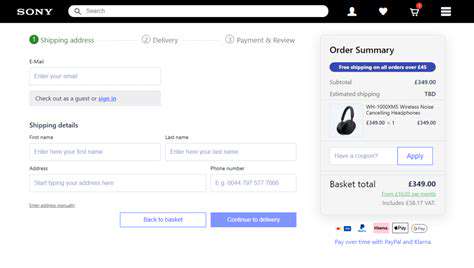The Power of Persuasion in Online Stores
Understanding the Psychology of Consumer Behavior
Online stores leverage the psychology of consumer behavior to influence purchasing decisions. This involves understanding the motivations, needs, and desires of their target audience. For instance, emphasizing scarcity (only a few left!) or social proof (99% of buyers rated this product 5 stars) can dramatically alter a customer's perception of value and urgency. A deep grasp of these psychological triggers enables businesses to craft marketing strategies that resonate with potential buyers and boost sales. It's not just about aesthetics; it's about forging a genuine connection with the customer and making them feel understood and valued.
Recognizing the role of emotions in the buying process is essential. Fear of missing out (FOMO), the desire for social approval, and the need for validation are all potent motivators. Online stores can tap into these emotions through strategically placed visuals, persuasive language, and testimonials. By understanding the interplay between logic and emotion, e-commerce businesses can create a more compelling and persuasive online experience, ultimately leading to higher conversion rates.
Applying Persuasion Techniques in E-commerce
Various persuasive techniques are employed in online stores to sway consumer choices. These techniques go beyond merely presenting products; they aim to shape the customer's perception and create a desire for the offered items. Scarcity, as mentioned earlier, is a powerful tool. Limiting quantities or offering time-sensitive deals can create a sense of urgency and encourage immediate purchases. Social proof, through testimonials and reviews, builds trust and credibility, making customers more likely to believe in the product's value.
Another effective technique is reciprocity. Offering incentives like free shipping or exclusive discounts can make customers feel obligated to reciprocate by making a purchase. Anchoring, which involves presenting a higher-priced item first, can make a lower-priced alternative seem more attractive, thus influencing the perceived value of the target product. Expertly using these techniques creates a seamless and persuasive online shopping journey.
Moreover, framing products in a positive light is crucial. Highlighting benefits, rather than just features, emphasizes the value proposition for the customer. Storytelling, through product descriptions and marketing campaigns, fosters an emotional connection and creates a lasting impression. Understanding and applying these persuasion techniques can make a significant difference in driving online sales and achieving e-commerce goals.
Finally, personalization plays a key role. Tailoring the online experience to individual customer preferences creates a sense of exclusivity and relevance. This involves using data to understand customer behavior and offer products or deals that align with their needs and past purchases. Personalized recommendations and targeted ads can significantly enhance the effectiveness of persuasion in online stores.
Implementing these strategies, while ethically sound, allows e-commerce businesses to present their products in the best possible light, ultimately fostering a more positive and persuasive online shopping experience for the customer.
The Role of Perceived Value and Scarcity
Perceived Value and Consumer Behavior
Perceived value plays a crucial role in shaping consumer behavior in the e-commerce landscape. Consumers don't just evaluate a product based on its objective features; they also consider its perceived value, which encompasses their subjective assessment of the product's worth relative to its price and perceived benefits. This subjective assessment is influenced by factors like brand reputation, marketing messages, and social proof. Understanding how consumers perceive value is critical for e-commerce businesses to effectively position their products and services and drive sales.
A product perceived as offering significant value, even if it's not objectively the cheapest, can attract customers and drive higher conversion rates. This is because perceived value taps into a deeper psychological need for consumers to feel they are getting a good deal or a product that justifies the investment.
Scarcity and Urgency in Online Purchases
The principle of scarcity, a powerful psychological driver, can significantly influence purchasing decisions in e-commerce. Limited-time offers, exclusive products, and dwindling inventory can create a sense of urgency and motivate consumers to act quickly. This scarcity effect is rooted in the human tendency to value things more when they are perceived as rare or difficult to obtain. E-commerce platforms effectively leverage this by highlighting limited stocks, countdown timers, and exclusive pre-orders to boost sales.
The Impact of Social Proof on E-commerce Decisions
Social proof, the tendency of individuals to conform to the actions and beliefs of others, significantly influences e-commerce decisions. Positive reviews, testimonials, and ratings from other customers play a critical role in shaping consumer perceptions of a product's value and quality. Seeing that others have had a positive experience with a product builds trust and confidence, increasing the likelihood of purchase. E-commerce sites often utilize user-generated content strategically to showcase these positive experiences and build social proof.
Framing Products for Maximum Perceived Value
Effective framing of products is crucial in e-commerce. Presenting features and benefits in a way that highlights their value to the consumer is essential. Instead of simply listing specifications, e-commerce businesses can highlight how those specifications address specific consumer needs and problems. By focusing on the benefits, rather than just the features, businesses can effectively communicate the value proposition of their products and increase the likelihood of purchase.
The Role of Pricing Strategies in Perceived Value
Pricing strategies significantly impact how consumers perceive the value of a product. Strategies like anchoring, bundling, and tiered pricing can influence perceived value. Anchoring involves highlighting a higher-priced alternative to make the target product seem more affordable. Bundling combines multiple products at a discounted price, increasing perceived value. Tiered pricing structures create varying levels of value, catering to different consumer budgets and needs.
Psychological Pricing Tactics in E-commerce
Psychological pricing tactics are used extensively in e-commerce to manipulate consumer perception of value. Strategies like ending prices with 9 (e.g., $9.99) or using discount percentages can create a sense of a better deal. These tactics exploit the human tendency to focus on the first few digits of a price and often lead to higher conversion rates. E-commerce businesses need to be mindful of the ethical implications of such tactics.
The Intersection of Scarcity and Perceived Value
The intersection of scarcity and perceived value can be a potent combination in e-commerce. When a product is both rare and perceived as offering high value, the result can be a significant increase in demand. This synergy creates a powerful incentive for consumers to act quickly, further amplifying the impact of both scarcity and perceived value on purchasing decisions. Effective e-commerce strategies often leverage this combination to drive sales and maximize profits.
The Impact of Visual Cues and Emotional Appeals
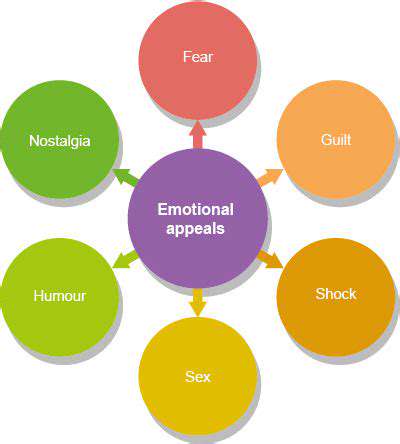
Visual Cues and Emotional Responses
Visual cues, encompassing everything from color palettes and imagery to the arrangement and composition of elements within a design, play a significant role in eliciting emotional responses in viewers. Understanding how these visual elements interact with the human brain is crucial for crafting compelling and effective communication. The careful selection of colors, for example, can evoke feelings of warmth, coolness, joy, or serenity, influencing the overall emotional tone of a piece of work.
Furthermore, the use of specific imagery can powerfully connect with viewers on a deeper level, triggering memories, associations, and emotions. A well-chosen image can instantly communicate a concept or evoke a particular feeling, making it an invaluable tool in design and communication. Effective visual communication understands that the right image can speak volumes, conveying meaning beyond the limitations of words alone.
Emotional Contagion and Visual Design
Emotional contagion, the phenomenon where emotions spread from one person to another, is a powerful force in human interaction. In visual design, this principle underscores the importance of carefully considering how the design elements might subconsciously influence the viewer's emotional state. Effective designs often leverage emotional contagion to create a shared experience and connect with the audience on a more profound level.
Visual communication is more than just aesthetics; it's a subtle form of emotional persuasion. The skillful use of visual cues can tap into pre-existing emotional responses, creating a resonance with the audience. By understanding and employing these strategies, designers and communicators can craft experiences that resonate with viewers on an emotional level, thereby achieving a deeper impact.
The interplay between visual cues and emotions extends beyond simple aesthetics. A well-designed interface can foster feelings of trust, security, and ease of use. Conversely, a poorly designed one can instill feelings of frustration and anxiety. This underscores the critical role visual design plays in shaping user experience and ultimately influencing user behavior.
Careful consideration of these elements is paramount to effective visual design. The use of appropriate lighting, color schemes, and imagery directly impacts how a viewer feels and interprets the message.
Ultimately, the goal of visual communication is not merely to present information but to create an emotional connection with the audience. Understanding the psychological impact of visual cues is essential for achieving this goal.
Optimizing the Customer Journey Through Cognitive Biases

Understanding the Customer Journey
A successful business hinges on a deep understanding of the customer journey. This involves mapping out the entire sequence of interactions a customer has with a company, from initial awareness to post-purchase engagement. By meticulously analyzing each touchpoint, businesses can identify pain points and opportunities for improvement, leading to a more streamlined and satisfying experience for the customer.
Understanding the customer journey is not just about knowing what customers do, but also why they do it. What are their motivations, their needs, and their expectations at each stage? By delving into these factors, companies can tailor their offerings and interactions to resonate more effectively with their target audience.
Personalization for Enhanced Engagement
Personalization is crucial in optimizing the customer journey. Customers are more likely to engage with businesses that demonstrate a genuine understanding of their individual needs and preferences. This can be achieved through targeted messaging, customized recommendations, and personalized offers. Tailoring the customer experience to individual preferences fosters loyalty and drives repeat business.
By implementing personalized strategies, businesses can create a more relevant and engaging experience for customers. This can manifest in various ways, including personalized email campaigns, tailored product recommendations on websites, and bespoke customer service interactions.
Streamlining the Buying Process
A smooth and efficient buying process is paramount in a positive customer journey. This involves ensuring a seamless transition between different stages, from initial product discovery to final purchase confirmation. Reducing friction points, such as complex navigation or lengthy checkout procedures, is key to driving conversions. A streamlined buying process translates directly to higher customer satisfaction and increased sales.
Leveraging Technology for Efficiency
Technology plays a vital role in optimizing the customer journey. Utilizing tools like CRM systems, chatbots, and marketing automation software allows businesses to automate tasks, gather customer data, and personalize interactions on a large scale. These technologies enable businesses to respond promptly to customer inquiries, deliver personalized recommendations, and provide tailored support.
Measuring and Adapting for Continuous Improvement
Continuous monitoring and evaluation are essential for optimizing the customer journey. Tracking key metrics such as conversion rates, customer satisfaction scores, and website traffic provides valuable insights into the effectiveness of current strategies. Data analysis allows businesses to identify areas for improvement and make necessary adjustments to processes and offerings.
Adapting based on these insights is crucial for long-term success. Businesses need to be agile and responsive to changing customer needs and market trends, ensuring the customer journey remains relevant and effective over time. The ability to pivot and refine strategies based on data analysis is a key component of a truly optimized customer experience.
